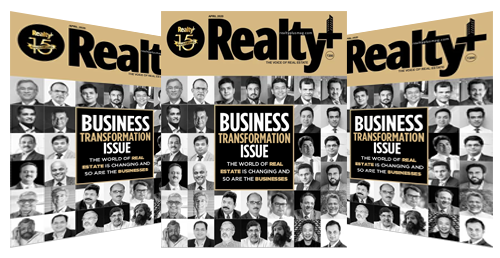In today's turbocharged digital landscape, technology parks are the engines of economic growth, talent magnets, and hotbeds of innovation. Keeping pace with the ‘Digital India’ the dynamic business parks are being designed to cater to the specific needs of IT/ ITES and IT ancillary sectors. The state-of-the-art infrastructure, cutting-edge technology, and a range of amenities are the hallmark of these technology parks that enable companies to flourish.
KEY DESIGN CONSIDERATIONS
The IT business parks are designed to offer a favourable setting for IT business activities by providing shared amenities, infrastructure, services and utilities to offer cost-effective solutions and a sense of community to the businesses.
According to Dr. Niranjan Hiranandani, Chairman - NAREDCO & Hiranandani Group modern business park design must balance functionality, sustainability, and attractiveness. “This requires flexible workplaces, collaborative spaces, robust infrastructure (fibre optics, uninterrupted utilities), and climate-resilient design incorporating natural ventilation and emergency exits. Additionally, there is a growing need for collaborative spaces, including breakout zones, green decks, and quiet areas. Critical infrastructure concerns such as fibre optic connectivity, and uninterrupted water and power supply, are paramount. The design must also harmonize with external weather and climatic conditions, incorporating natural ventilation and adequate emergency exits to ensure safety and comfort," he said.
Mahendra Mohan, Managing Director, MARS Architects enumerates the design strategy for tech parks. Site and Climatic Considerations - Take into account the site's orientation, prevailing winds, sunlight, and local climate for energy optimization. Design the layout to align with the site's natural topography and surroundings, promoting passive heating/cooling and ventilation. Efficient Floor Plate Design -Maximize usable space with flexibil- ity for future needs. Efficient layout should support varied workspace configurations, collaborative areas, and tech infrastructure.
Eco-friendly & Green Building Practices - Implement sustainable architecture using energy-efficient systems, renewable materials, and sustainable water management. Achieving green building certifications (LEED or equivalent) will promote environmental responsibility Traffic Planning & Security - Strategic traffic flow management accommodates employees, visitors, and deliveries and comprehensive security system will include controlled access, CCTV surveillance, and efficient vehicular circulation, including parking provisions.
Proper Lift Core Placement & Natural Lighting - Thoughtful placement of lift cores for optimal vertical circulation and minimizing travel time between floors. Incorporating abundant natural light through sky-lights, large windows, and atriums to enhance employee well-being and reduce energy costs.
Naresh Narasimhan, Architect & Urban Designer, Venkataramanan Associates had begun experimenting with the idea of the Technology Park in the early 2000s while working on the campus for Infosys. “The concept came from making the workplace like a self- contained college campus where people would want to spend time beyond work. Also, “park” was interpreted literally to mean that the buildings would sit within green landscaped spaces with access between the outside and interiors modulated through semi covered spaces which could be naturally ventilated. However given the current exigencies of climate change, the top five design considerations today necessarily take into consideration climate responsiveness through passive design strategies and high energy performance, sustainable construction and materials, adaptability to the changing needs of the client, spatial environments that promote employee well-being, and creating a distinct identity for the campus through formal and material design choices,” he stated.
Chandrakant S Kanthigavi, Founder and Principal Architect, 4site architects was of the view that designing a technology park requires careful planning to foster innovation, collaboration and functionality. Flexible Workspace design (Me): Incorporate adaptable workspaces that can accommodate different team sizes and project/ research needs. This includes open-plan ar- eas, private offices and collaborative zones to promote creativity and teamwork.
Community Engagement Collaborative Spaces (We): Create areas for collaborative spaces for shared knowledge interactive workspaces for research and project purposes. This could include informal labs, huddle spaces, lounges and shared meeting rooms. To encourage Socio-cultural interaction among Multiple tenants and fos- ter a sense of community informal cafés, informal gathering spaces, Multipurpose spaces and Sports / Wellness centre can foster a sense of Community.
Technology Driven Spaces (Me and We): Provision of robust infrastructure for high-speed internet, smart building systems, and tech-friendly amenities. Technology driven spaces for help bring in collaboration across people and allow seamless connection across geographical locations.
Accessibility & Transportation (Mobility/ Movement): Design for easy access to public transport (Road/ Metro/BRTS), cycling paths and ample parking. Ensure the Design layout accommodates all users, including those with disabilities.
Performative infrastructure & Buildings (Sustainable): Prioritize eco-friendly infrastructure for optimum energy, water and Waste Management. All the Buildings to use Technology to efficient for Wa- ter and energy. The building to be designed for lesser solar heat gain and optimum Day light and better water management, renewable en- ergy sources.
INTEGRATING ‘PLUG & PLAY'
Today, due the nature of work, technology, and society, workspaces also need to be highly adaptable. Designs for information technolo- gy buildings need to cater to the changing spatial and hardware requirements, but more crucially one needs to accommodate the variable energy requirements.
Naresh Narasimhan gave the example of Wipro Kodathi campus in Bengaluru. “Adaptability was addressed right from how to phase the planning and construction of the project. The Masterplan had to be able to address incremental spatial requirements without disturbing ongoing operations. At the local scale, the building systems were designed for maximum efficiencies. The extensive use of a false floor in the towers future proofed the offices for updating new hardware and replacing obsolete networking systems. Under-floor air distribution systems allowed for HVAC circulation through the false floor. The benefits of this system included reduced operational cost on chiller units, reduced ceiling heights as one could avoid ductwork or drop ceilings and the general flexibility and adaptability to the needs of the user. All these in-built efficiencies also resulted in minimising the maintenance and operational costs of the project while maximising user comforts.”
Dr. Niranjan Hiranandani stated, “The 'plug and play' concept is integrated into building designs to enhance flexibility, efficiency, and adaptability. Buildings are crafted to seamlessly incorporate plug-and-play systems for energy management, as well as pre-configured elements for specific functionalities such as HVAC systems, security fea- tures, and IT infrastructure. These systems are designed to be easily expandable and reconfigurable, facilitating straightforward maintenance and renovations. Moreover, the plug-and-play approach ensures that building modifications can be executed with minimal disruption and increased cost-effectiveness.”
Mahendra Mohan concurred, “Incorporating the ‘plug & play’ requirement in building design focuses on flexibility and efficiency. A proper column grid allows open spaces to be easily reconfigured, with stan- dards like 100 sq. ft. per person but adaptable to different tenant needs. Accessibility and smooth movement are prioritized with well-placed stair- wells and elevators. For multi-tenant use, the floor plate must allow easy division and expansion, with parti- tions and systems designed for minimal disruption. Dedicated entrances and utilities for different tenants ensure operational independence, creating a versatile, tenant-ready environment that's quick to adapt.”
Chandrakant S Kanthigavi lists the ways ‘plug & play’ concept is incorporated: Standardized furniture systems: Use standardized modular furniture and fixtures that can be added or removed as needed, making it easy to update or change the function of a space.
Technology Integration: Incorporate smart building technologies that allow for easy integration of new systems or upgrades without extensive rewiring or structural changes. Modular Spaces: Design areas that can be easily reconfigured with movable walls or partitions, allowing for quick changes in layout. Utility Infrastructure: Install flexible utility systems (like electrical and plumbing) that can be easily accessed and modified. This includes having outlets and connections in strategic locations. Future-Proof design: Anticipate future needs by designing spaces that can accommodate technological advancements or changes in use without major structural changes.
INCORPORATING 'WALK TO WORK'
'Walk to work' concepts are being integrated by creating mixed-use developments within the IT park. Mahendra Mohan explained, “This involves including residential spaces, recreational zones, and amenities that support a balanced work-life environment. The landscape and layout are designed to promote pedestrian-friendly pathways and connectivity between workspaces and living areas, reducing dependence on transportation.”
Dr. Niranjan Hiranandani added, “Post Covid, the industry has witnessed a significant shift in residential and commercial spaces, with the mixed-use development model gaining prominence. This changed approach integrates residential clusters and business parks in proximity, allowing consumers to opt for a "walk to work" setup or significantly reduce commuting times. Today's workforce prioritizes working near home to avoid lengthy commutes, thereby improving efficiency and health. These urban hubs offer residential accommodations, retail, and recreational zones all in one destination, foster fostering an inclusive community and enhancing the overall quality of life.”
DESIGNING 'FUTURE READY' IT PARK
As per Chandrakant S Kanthigavi, "Creating modular workspaces can easily be reconfigured for different team sizes or projects. Incorporate movable walls and multi-purpose areas to accommodate various functions. Integrate smart technologies, such as IoT devices for building management, energy efficiency monitoring, and advanced security systems. This can enhance operational efficiency and provide data-driven insights. But one needs to carefully integrate utilities (like power, water, and data). This requires careful planning to accommodate future technological needs, such as high-speed internet and smart building systems, while coordinating with local infrastructure to prevent conflicts. Prioritise eco-friendly practices, including energy-efficient systems, renewable energy sources, and sustainable materials, also considering economic and social resilience. Integrated planning must address climate adaptation strategies, resource management, and long-term viability, ensuring that the park can evolve with changing circumstances. Effective zoning and land use planning are necessary to create a vibrant environment that supports work-life balance, encourages community interaction, and meets diverse stakeholder needs.”
Mahendra Mohan agreed, “Modular designs allow for the quick transformation of spaces to meet evolving needs. Smart building technologies, like IoT, AI-driven management systems, and energy-efficient designs, ensure sustainability and adaptability to future trends. Additionally, planning for infrastructure that supports future tech advancements, such as 5G networks, electric vehicle charging, and renewable energy systems, is essential to stay ahead. However, the challenge is to balance flexibility with functionality, ensuring spaces can adapt without compromising core design goals. Seamlessly integrating smart technologies while main- taining robust security and infrastructure and achieving sustainability while keeping the project cost-effective is a major consideration.”
According to Naresh Narasimhan “Every aspect of the building design should be guided by principles of building performance, including master plan, building design, building systems, construction systems, façade design and climate responsiveness, and materiality. The most challenging decisions in designing an IT park begin with the masterplan, where one can establish the creative direction of the project, taking into account topography, orientation, natural features and the micro-climate. As one zooms in from the site to the buildings one needs to factor in the performance of the buildings, which can first be addressed through passive strategies, then enhanced through active building systems which improve user comfort and wellbeing. And finally, the design must establish a unique identity for the project and the client.”
In conclusion Dr. Niranjan Hiranandani rightly states,“A 'future ready' Business Park must seamlessly integrate innovative design, advanc1ed technology, sustainability, and flexibility to meet the dynamic needs of modern businesses and workforces. To enrich the work experience, the park should offer entertainment and healthcare amenities, cafes, pedestrian-friendly infrastructure, and on-demand services like concierge and housekeeping, ensuring a resilient, vibrant, and productive environment for all.”
Designing a future-ready IT park requires flexibility and adaptability while, balancing workspace, residential, and recreational areas, that can be complex. The notion of resiliency in buildings needs to be looked at holistically, using a bottom- up approach.
Keeping pace with India's turbocharged digital landscape, the business parks are being designed to cater to the specific needs of IT/ITES and IT ancillary sectors, equipped with cutting- edge technology, infrastructure & amenities that can enable companies to flourish.

_pages-to-jpg-0001.jpg)











